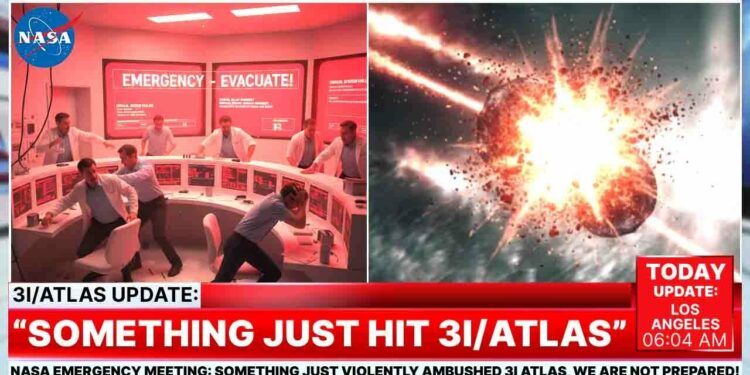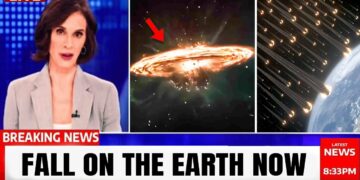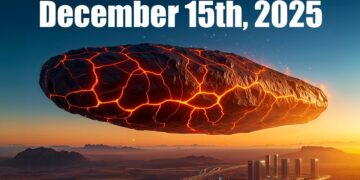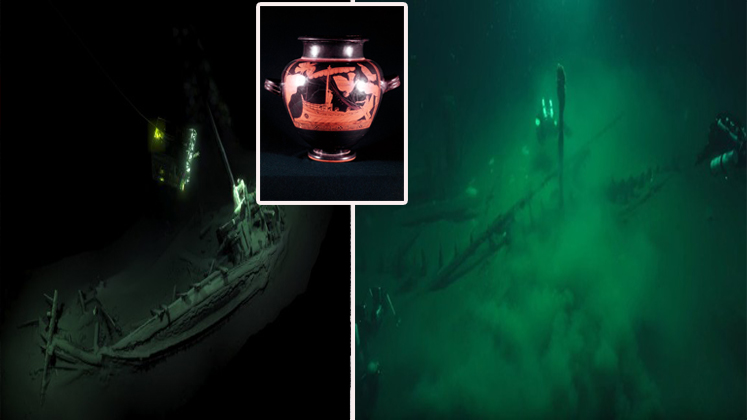Fresh images of Three Eye Atlas, the third interstellar object ever observed from Earth, have revealed a shocking event in our solar system. This interstellar comet, once a beacon of scientific curiosity, was violently disrupted by an unknown force, sending shockwaves through the astronomical community and prompting an unprecedented NASA emergency meeting. Below, we explore the astonishing details of this incident, its implications for our understanding of the cosmos, and why it exposes a terrifying gap in humanity’s defenses.
A Shattered Visitor
Astronomers captured live footage of Three Eye Atlas as it raced through our solar system, streaming in real time via the Deep Space Network. Suddenly, data streams went haywire, registering a massive energy spike—akin to a cosmic blast—followed by a rapid, violent deceleration. The comet’s vibrant green and blue tail, stretching hundreds of thousands of miles, fragmented into a chaotic dust cloud. This was no gradual breakup caused by solar winds or tidal forces; it was an abrupt, destructive intervention.
Telemetry data showed the comet’s nucleus, roughly half a mile across, torn apart into spiraling fragments surrounded by billions of icy shards reflecting distant sunlight. The energy release was staggering, equivalent to thousands of megatons of TNT, yet no precursor events—stellar flares, rogue black holes, or other known phenomena—could account for it. The signals from probes observing Three Eye Atlas went dark, transitioning from pristine data to utter chaos in moments. Most shockingly, the event defied every known natural astronomical phenomenon.
An Unprecedented Cosmic Event
Three Eye Atlas, an interstellar comet traveling at approximately 100,000 mph, was a substantial mass of primordial ice and rock. For an object of this size to be so violently disrupted, an impactor of significant size and velocity—or an energy source beyond current scientific understanding—would be required. The suddenness of the event left no time for warnings or evasion, resembling a cosmic sneak attack.
The absence of a detectable impactor is particularly chilling. Our orbital telescopes and ground-based radar systems, capable of tracking objects as small as a softball in Earth’s orbit, saw nothing approaching Three Eye Atlas before the impact. The event’s energy signature suggested a concentrated, powerful blow, not a diffuse cloud of particles. Yet, no residual gravitational effects or electromagnetic signatures were detected, as if the cause ceased to exist after striking.
A Unique Interstellar Traveler
Interstellar objects like Three Eye Atlas are rare, offering glimpses into distant star systems. Unlike its predecessor, ‘Oumuamua—a cigar-shaped object with no cometary activity—Three Eye Atlas was a textbook comet, actively outgassing with a visible tail. Its destruction, occurring roughly 400 million miles from Earth, well beyond Mars’ orbit, rules out solar radiation or gravitational stresses from nearby planets as causes. The comet was a lone traveler, seemingly immune to common cosmic forces until its abrupt end.
A Terrifying Gap in Our Defenses
The NASA emergency meeting was marked by panic and urgency. Director Thorne, known for her calm demeanor, admitted, “We are not prepared.” The incident exposed critical vulnerabilities in our planetary defense systems, which are designed to detect and track known threats like asteroids and comets. However, the ambush of Three Eye Atlas suggests a class of threats we cannot perceive until it’s too late.
Our telescopes, including Hubble and James Webb, are engineered to detect light, radiation, or gravitational signatures. Yet, whatever struck Three Eye Atlas left no such traces. Proposals to send probes to the debris field or analyze past telescope data face significant challenges, as the debris is now too dispersed, and retrospective analysis is akin to finding a needle in a cosmic haystack.
Theories and Speculation
While some speculate about alien involvement, scientists are rigorously exploring natural explanations, such as dark matter events, exotic particle interactions, or micro black holes. However, no current theory fully explains the suddenness, energy, and lack of residual evidence. The event challenges our assumption that space is largely empty and predictable, suggesting a more complex and potentially hostile cosmic reality.
Implications for Cosmic Exploration
The destruction of Three Eye Atlas raises profound questions about the safety of future deep-space missions. If interstellar objects can be ambushed without warning, how secure are missions to Mars or beyond? Our planetary defense strategies rely on detecting visible threats, but this incident highlights the need for revolutionary detection technologies capable of sensing subtle gravitational disturbances or exotic phenomena.
A Call to Action
The ambush of Three Eye Atlas is a stark reminder of our technological limitations. Despite our ability to peer across billions of light-years or land rovers on Mars, we remain blind to threats that don’t emit or reflect detectable signals. This event demands a re-evaluation of our place in the cosmos and the development of new systems to detect the undetectable.
The universe is full of surprises, but this one feels deliberate, almost targeted. The question remains: Is what struck Three Eye Atlas still out there, lurking in the void? The incident has left humanity with unsettling questions and an urgent need to uncover the truth about our cosmic neighborhood.






















